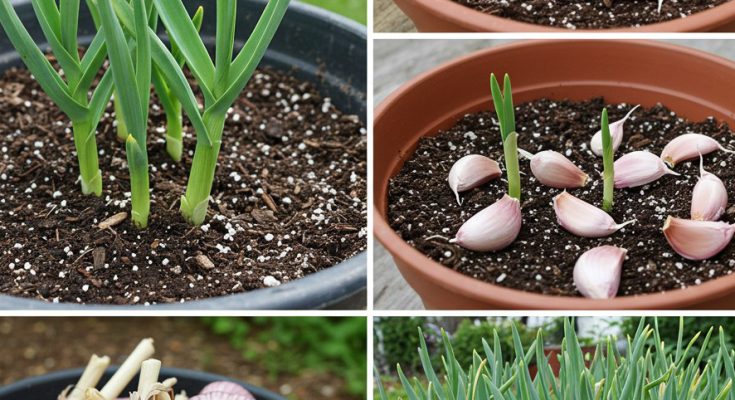The Importance of Fertilizing Garlic
Garlic, like any other plant, requires essential nutrients for optimal growth. These nutrients are absorbed from the soil, and if the soil is lacking in any of these essential minerals, your garlic may not grow as well as it could. Typically, garlic needs nitrogen, phosphorus, and potassium for healthy growth. Nitrogen supports leaf growth, phosphorus aids in root development, and potassium helps with overall plant health, especially when the plant starts to form bulbs.
However, garlic also benefits from micronutrients like calcium, magnesium, and sulfur. These not only help with the structure of the bulb but also improve its flavor and preservation ability. So, how can you provide your garlic with all these necessary nutrients without relying on synthetic fertilizers?
A Natural Fertilizer That Garlic Loves
Here’s a simple and effective homemade fertilizer that will boost your garlic crop and encourage bigger, healthier bulbs. This all-natural solution can help restore the balance of nutrients your garlic needs to thrive.
Ingredients:
-
-
1 liter of water
-
-
-
1 tablespoon of wood ash (for potassium)
-
1 tablespoon of crushed eggshells (for calcium)
-
1 teaspoon of Epsom salt (for magnesium)
-
-
1 tablespoon of fish emulsion (a natural source of nitrogen)
Instructions:
-
-
In a large container, mix the wood ash and crushed eggshells with the water.
-
Stir in the Epsom salt and fish emulsion.
-
-
-
Allow the mixture to sit for a few hours to dissolve.
-
Strain the mixture (optional) and apply directly to the garlic plants at the base.
-
Repeat this every 2-3 weeks during the growing season.
-
This homemade fertilizer not only provides the necessary macro and micronutrients but also works to enrich the soil, improve soil structure, and increase the availability of nutrients to your garlic plants.
Why This Fertilizer Works for Garlic
-
-
Wood Ash is an excellent source of potassium, which is essential for garlic as it helps to form strong bulbs and improves overall plant health.
-
-
-
Crushed Eggshells are rich in calcium, which helps the garlic develop strong, firm bulbs and prevents conditions like blossom-end rot.
-
Epsom Salt provides magnesium, which is essential for chlorophyll production and helps the plant carry out photosynthesis efficiently.
-
Fish Emulsion provides organic nitrogen, encouraging healthy foliage and robust growth during the vegetative stages of garlic development.
-
By combining these natural ingredients, you’re not only feeding your garlic plants but also ensuring they have the right balance of nutrients at every growth stage.
When and How to Apply Fertilizer
The timing of your fertilizer application is critical for garlic. You don’t want to over-fertilize, especially with nitrogen, as this can lead to excessive leaf growth at the expense of bulb development. Here’s how to apply the fertilizer effectively:
-
-
Before Planting: If you’re planting garlic in the fall, mix some of this fertilizer into the soil before planting. This will give the garlic bulbs a strong start with the necessary nutrients they need to establish their roots.
-
During Growth: Garlic grows best in nutrient-rich soil, so once the plants begin to emerge in spring, start applying the fertilizer. Focus on applying it every 2–3 weeks during the growing season to support steady, healthy growth.
-
-
Avoid Applying Too Late: Garlic begins to form bulbs in mid-to-late spring. Avoid adding too much fertilizer at this stage as it can lead to overly lush greenery with smaller bulbs. Reduce fertilization as the plant starts to mature, particularly once the bulbs begin to form.
Other Tips for Growing Healthy Garlic
-
-
Soil Preparation: Garlic thrives in well-drained, loamy soil. Ensure the soil is loose and free of large clumps to allow for proper root development.
-
Mulching: Use straw, hay, or compost to mulch around your garlic plants. This helps retain moisture, suppresses weeds, and improves soil structure.
-
-
-
Watering: Garlic needs consistent moisture, but it doesn’t like to be waterlogged. Water deeply, but allow the soil to dry out between waterings to prevent rot.
-
Pest Control: Keep an eye out for pests like aphids and onion flies. If you spot any, remove them immediately, as they can interfere with your garlic’s growth.
-
Harvesting: Garlic is ready to harvest when the leaves begin to yellow and dry out. Be sure to lift the bulbs carefully to avoid damaging them, and allow them to dry completely in a shaded, ventilated area before storing.
-
Conclusion
Growing garlic doesn’t have to be complicated, but it does require the right care and attention to detail. Using this natural fertilizer made of wood ash, eggshells, Epsom salt, and fish emulsion will give your garlic the perfect balance of nutrients to ensure strong, healthy growth and large, flavorful bulbs.
By following this simple method and applying it at the right times, you can dramatically improve your garlic harvest, avoiding common pitfalls and ensuring an abundance of homegrown garlic each year.

